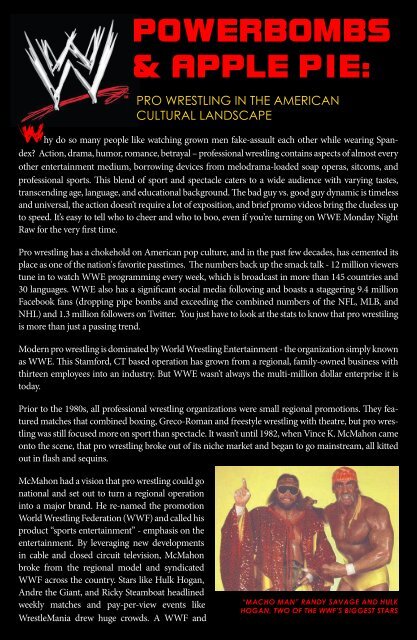our supporters - Company One
our supporters - Company One
our supporters - Company One
You also want an ePaper? Increase the reach of your titles
YUMPU automatically turns print PDFs into web optimized ePapers that Google loves.
POwERBOmBs<br />
& APPLE PIE:<br />
PRO WREStLING IN tHE AMERICAN<br />
CuLtuRAL LANDSCAPE<br />
Why do so many people like watching grown men fake-assault each other while wearing Spandex?<br />
action, drama, humor, romance, betrayal – professional wrestling contains aspects of almost every<br />
other entertainment medium, borrowing devices from melodrama-loaded soap operas, sitcoms, and<br />
professional sports. This blend of sport and spectacle caters to a wide audience with varying tastes,<br />
transcending age, language, and educational background. The bad guy vs. good guy dynamic is timeless<br />
and universal, the action doesn’t require a lot of exposition, and brief promo videos bring the clueless up<br />
to speed. It’s easy to tell who to cheer and who to boo, even if you’re turning on WWe monday Night<br />
raw for the very first time.<br />
Pro wrestling has a chokehold on american pop culture, and in the past few decades, has cemented its<br />
place as one of the nation's favorite passtimes. The numbers back up the smack talk - 12 million viewers<br />
tune in to watch WWe programming every week, which is broadcast in more than 145 countries and<br />
30 languages. WWe also has a significant social media following and boasts a staggering 9.4 million<br />
Facebook fans (dropping pipe bombs and exceeding the combined numbers of the NFl, mlB, and<br />
Nhl) and 1.3 million followers on twitter. You just have to look at the stats to know that pro wrestiling<br />
is more than just a passing trend.<br />
modern pro wrestling is dominated by World Wrestling entertainment - the organization simply known<br />
as WWe. This Stamford, Ct based operation has grown from a regional, family-owned business with<br />
thirteen employees into an industry. But WWe wasn’t always the multi-million dollar enterprise it is<br />
today.<br />
Prior to the 1980s, all professional wrestling organizations were small regional promotions. They featured<br />
matches that combined boxing, Greco-roman and freestyle wrestling with theatre, but pro wrestling<br />
was still focused more on sport than spectacle. It wasn’t until 1982, when Vince K. mcmahon came<br />
onto the scene, that pro wrestling broke out of its niche market and began to go mainstream, all kitted<br />
out in flash and sequins.<br />
mcmahon had a vision that pro wrestling could go<br />
national and set out to turn a regional operation<br />
into a major brand. he re-named the promotion<br />
World Wrestling Federation (WWF) and called his<br />
product “sports entertainment” - emphasis on the<br />
entertainment. By leveraging new developments<br />
in cable and closed circuit television, mcmahon<br />
broke from the regional model and syndicated<br />
WWF across the country. Stars like hulk hogan,<br />
andre the Giant, and ricky Steamboat headlined<br />
weekly matches and pay-per-view events like<br />
Wrestlemania drew huge crowds. a WWF and<br />
“MAChO MAN” RANDY SAvAge AND huLK<br />
hOgAN, tWO OF the WWF’S biggeSt StARS


